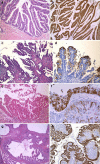Pancreatic intraductal papillary-mucinous neoplasms: a new and evolving entity
- PMID: 17899180
- PMCID: PMC2063564
- DOI: 10.1007/s00428-007-0512-6
Pancreatic intraductal papillary-mucinous neoplasms: a new and evolving entity
Abstract
For a long time, intraductal tumors of the pancreas were neglected because they were misdiagnosed as mucinous cystadenocarcinoma, ordinary ductal adenocarcinoma, or chronic pancreatitis. Only in recent years have they been recognized as clinical and pathological entities. Most common are the intraductal papillary-mucinous neoplasms. Although they show an adenoma-carcinoma sequence, they have proved to have a more favorable prognosis than ductal adenocarcinoma, when resected in a preinvasive state. Recently, it has become clear that they constitute a heterogeneous group with at least four subtypes. Their stratification reveals that the various intraductal papillary-mucinous neoplasm subtypes have different biological properties with different prognostic implications.
Figures




Similar articles
-
Intraductal papillary-mucinous neoplasms: a new and evolving entity among the pancreatic tumors.Verh Dtsch Ges Pathol. 2007;91:66-73. Verh Dtsch Ges Pathol. 2007. PMID: 18314597 Review.
-
Clinicopathologic characteristics of patients with resected multifocal intraductal papillary mucinous neoplasm of the pancreas.Surgery. 2012 Sep;152(3 Suppl 1):S74-80. doi: 10.1016/j.surg.2012.05.025. Epub 2012 Jul 6. Surgery. 2012. PMID: 22770954
-
Characterization of CD24 expression in intraductal papillary mucinous neoplasms and ductal carcinoma of the pancreas.Hum Pathol. 2010 Oct;41(10):1466-74. doi: 10.1016/j.humpath.2010.04.004. Hum Pathol. 2010. PMID: 20619441
-
Intraductal papillary-mucinous tumors of the pancreas.Hepatogastroenterology. 2004 Sep-Oct;51(59):1489-94. Hepatogastroenterology. 2004. PMID: 15362784
-
[Intraductal papillary mucinous neoplasm of the pancreas, IPMN].Duodecim. 2013;129(6):591-8. Duodecim. 2013. PMID: 23614224 Review. Finnish.
Cited by
-
Cyst Fluid Biosignature to Predict Intraductal Papillary Mucinous Neoplasms of the Pancreas with High Malignant Potential.J Am Coll Surg. 2019 May;228(5):721-729. doi: 10.1016/j.jamcollsurg.2019.02.040. Epub 2019 Feb 19. J Am Coll Surg. 2019. PMID: 30794864 Free PMC article.
-
Intraductal Papillary Mucinous Neoplasm of the Pancreas: Understanding the Basics and Beyond.Cureus. 2019 Jan 11;11(1):e3867. doi: 10.7759/cureus.3867. Cureus. 2019. PMID: 30899618 Free PMC article. Review.
-
Intraductal papillary-mucinous neoplasia of the pancreas: Histopathology and molecular biology.World J Gastrointest Surg. 2010 Oct 27;2(10):306-13. doi: 10.4240/wjgs.v2.i10.306. World J Gastrointest Surg. 2010. PMID: 21160835 Free PMC article.
-
Negative correlation between the nuclear size and nuclear Lamina component Lamin A in intraductal papillary mucinous neoplasms of the pancreas.Pathol Oncol Res. 2022 Dec 6;28:1610684. doi: 10.3389/pore.2022.1610684. eCollection 2022. Pathol Oncol Res. 2022. PMID: 36561231 Free PMC article.
-
Loss of PTEN expression is associated with poor prognosis in patients with intraductal papillary mucinous neoplasms of the pancreas.Clin Cancer Res. 2013 Dec 15;19(24):6830-41. doi: 10.1158/1078-0432.CCR-13-0624. Epub 2013 Oct 16. Clin Cancer Res. 2013. PMID: 24132918 Free PMC article.
References
-
- {'text': '', 'ref_index': 1, 'ids': [{'type': 'DOI', 'value': '10.1016/S0046-8177(03)00337-X', 'is_inner': False, 'url': 'https://doi.org/10.1016/s0046-8177(03)00337-x'}, {'type': 'PubMed', 'value': '14562286', 'is_inner': True, 'url': 'https://pubmed.ncbi.nlm.nih.gov/14562286/'}]}
- Abraham SC, Lee JH, Hruban RH, Argani P, Furth EE, Wu TT (2003) Molecular and immunohistochemical analysis of intraductal papillary neoplasms of the biliary tract. Hum Pathol 34:902–910 - PubMed
-
- {'text': '', 'ref_index': 1, 'ids': [{'type': 'DOI', 'value': '10.1097/00000478-199608000-00007', 'is_inner': False, 'url': 'https://doi.org/10.1097/00000478-199608000-00007'}, {'type': 'PubMed', 'value': '8712298', 'is_inner': True, 'url': 'https://pubmed.ncbi.nlm.nih.gov/8712298/'}]}
- Adsay NV, Adair CF, Heffess CS, Klimstra DS (1996) Intraductal oncocytic papillary neoplasms of the pancreas. Am J Surg Pathol 20:980–994 - PubMed
-
- {'text': '', 'ref_index': 1, 'ids': [{'type': 'DOI', 'value': '10.1002/cncr.10203', 'is_inner': False, 'url': 'https://doi.org/10.1002/cncr.10203'}, {'type': 'PubMed', 'value': '11815961', 'is_inner': True, 'url': 'https://pubmed.ncbi.nlm.nih.gov/11815961/'}]}
- Adsay NV, Conlon KC, Zee SY, Brennan MF, Klimstra DS (2002) Intraductal papillary-mucinous neoplasms of the pancreas. An analysis of in situ and invasive carcinomas in 28 patients. Cancer 94:62–77 - PubMed
-
- {'text': '', 'ref_index': 1, 'ids': [{'type': 'DOI', 'value': '10.1097/00000478-200407000-00001', 'is_inner': False, 'url': 'https://doi.org/10.1097/00000478-200407000-00001'}, {'type': 'PubMed', 'value': '15223952', 'is_inner': True, 'url': 'https://pubmed.ncbi.nlm.nih.gov/15223952/'}]}
- Adsay NV, Merati K, Basturk O, Iacobuzio-Donahue C, Levi E, Cheng JD, Sarkar FH, Hruban RH, Klimstra DS (2004) Pathologically and biologically distinct types of epithelium in intraductal papillary mucinous neoplasms. Delineation of an “intestinal” pathway of carcinogenesis in the pancreas. Am J Surg Pathol 28:839–848 - PubMed
-
- {'text': '', 'ref_index': 1, 'ids': [{'type': 'DOI', 'value': '10.1097/00000478-200101000-00003', 'is_inner': False, 'url': 'https://doi.org/10.1097/00000478-200101000-00003'}, {'type': 'PubMed', 'value': '11145249', 'is_inner': True, 'url': 'https://pubmed.ncbi.nlm.nih.gov/11145249/'}]}
- Adsay NV, Pierson C, Sarkar F, Abrams J, Weaver D, Conlon KC, Brennan MF, Klimstra DS (2001) Colloid (mucinous noncystic) carcinoma of the pancreas. Am J Surg Pathol 25:26–42 - PubMed
Publication types
MeSH terms
LinkOut - more resources
Full Text Sources
Other Literature Sources
Medical

